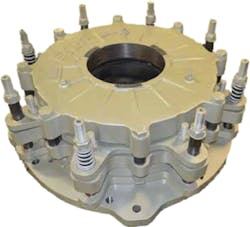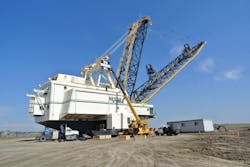The Sheerness Mine, located at Hanna, northeast of Calgary, Alberta, operates around the clock to produce fuel for the nearby Sheerness Generating Station that has two coal-fired electricity-generating units. A key piece of equipment at the mine is a huge BE1300 electric dragline excavator. As in any dragline, the bucket, suspended from the boom, is maneuvered using hoist and drag cables. Each cable system has a drum, driven through a gearbox by two motors, and each of the four motors was originally fitted with traditional drum/clamshell braking systems. The brakes manage the motion of the drag and hoist lines while the dragline excavator works, as well as providing an essential emergency braking function. The drum/clamshell system is a three-bar linkage that actuates two shoes against the rotating drum. An air cylinder holds the brake open during operation; a spring slams it shut when the air exhausts. (The excavator is fitted with an air compressor that fills a pressure tank located near the brakes.)
Solving a problem
A problem: the BE 1300’s antiquated braking system was requiring frequent repair that involved 4 to 8 hr of downtime for each incident. (A fair amount of specialized knowledge is needed to maintain the old clamshells and make sure everything is lined up and functioning properly.) “We needed a brake solution that was moreEaton supplied its heavy-duty, air-cooled, spring-applied/pressure-released Airflex 138FHB (floating housing brake) as a replacement. This patented braking concept employs a floating housing instead of a floating rotor. The disc brake’s full 360° annular disc extends friction pad wear life. And with this brake’s configuration, friction pads that can be changed in less than an hour … instead of 3 hr or more for alternative designs. Eaton’s “pizza-slice” configuration allows easy access to the friction pads, eliminating the old system’s need for a complete teardown just to replace a pad.
The 138FHB’s design not only reduces the time for each replacement, but the organic friction material also reduces the overall number of friction-pad replacements required. Instead of as many as six times per year, as claimed by a coal mining operation, the 138FHB’s friction-pad replacement is projected to be required approximately once every
five years.
Quicker, easier maintenance
As for major maintenance, dragline service providers estimate that drum removal is needed every two to three years. With clamshell brakes, this procedure requires heating equipment, a hydraulic press, and a full day of labor and downtime. Eaton’s TSL (tapered shaft-lock assembly) allows for faster and safer brake installation — without the need to heat and remove the drum with a hydraulic press. This not only saves time at installation, but also for routine maintenance.
In addition, the design combination of a TSL, solid rotor, and stationary friction material removes many of the wear issues associated with spline-and-gear designs. For example, the fixed hub and rotor eliminate wear during freewheeling.
Sheerness Mine’s maintenance supervisor and staff are impressed with the performance of the138FHB. “The brake is very robust,” said Spies. “It is serviceable if needed and runs well.”
Over time, the 138FHB is expected to significantly reduce frequent maintenance at Sheerness Mine and, by Eaton’s calculations, is projected to save more than $400,000 in downtime costs over five years. Eaton estimates that one 138FHB will pay for itself in three years with the savings provided by the reduced maintenance requirements.
Details about this application were provided by Paul Gardiner, or Eaton Corp. For more information visit
www.eaton/airflex.



